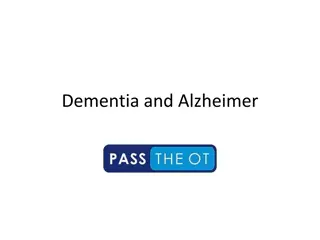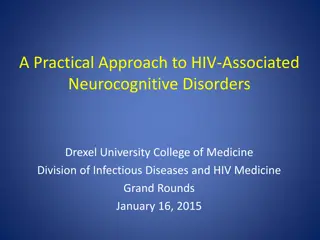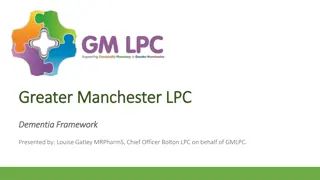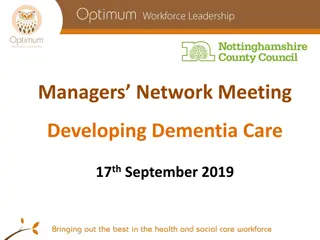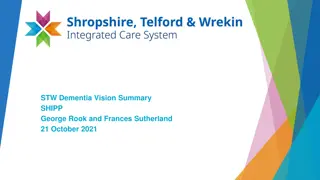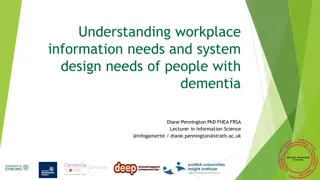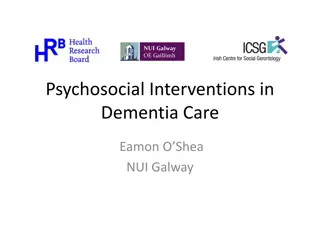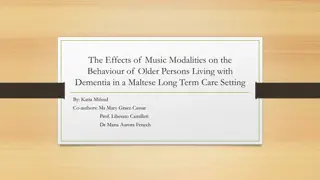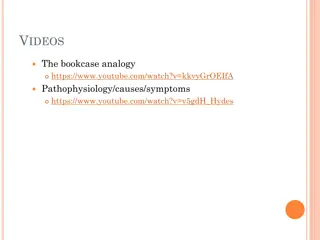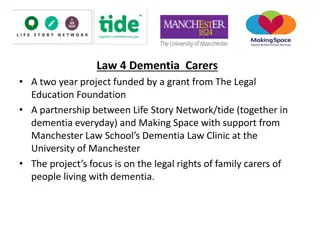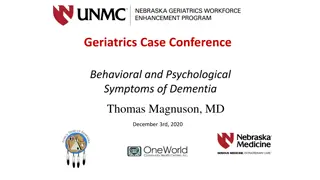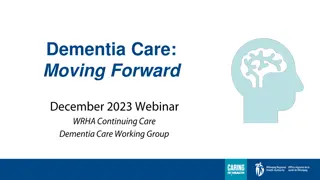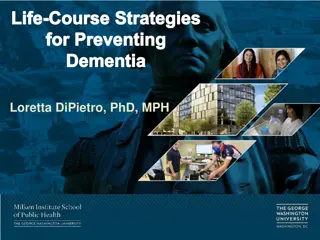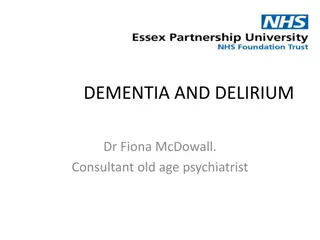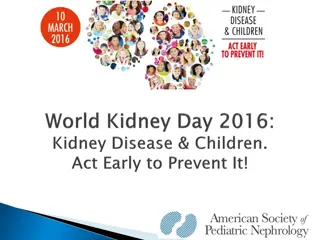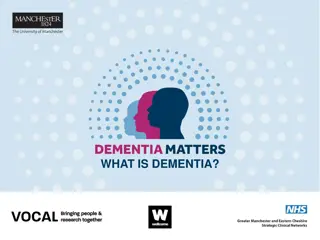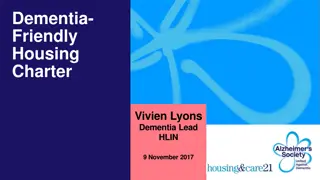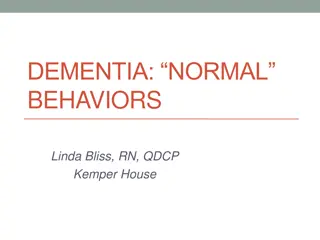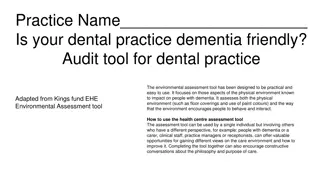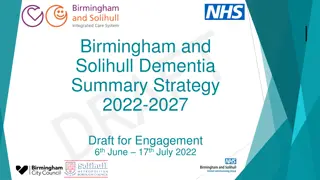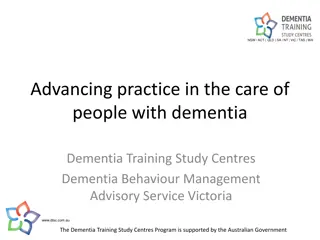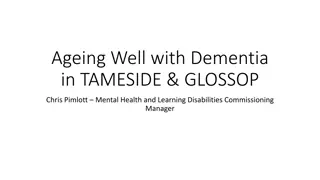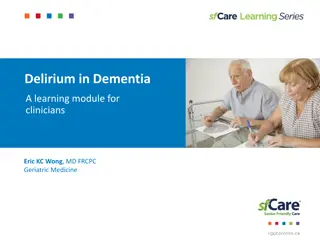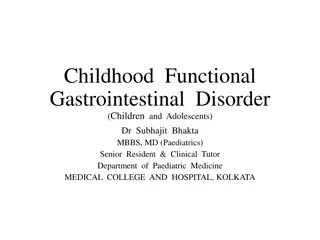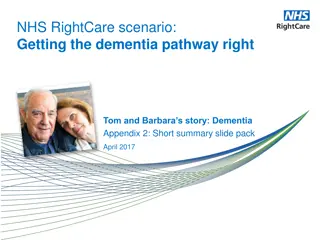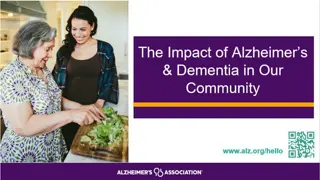Advancements in AI for Neurocognitive Disorders: Proposal for Early Detection of Dementia
This presentation highlights the urgent need for early detection and classification of dementia, a global public health priority. It discusses utilizing machine learning-based diagnostics with real-world brain imaging and genetic data to address Alzheimer's disease and related neurocognitive disorders. The proposal aims to leverage a vast dataset including clinical, diagnostic, cognitive, and biological measures to tackle the challenges of dementia research and care.
Download Presentation

Please find below an Image/Link to download the presentation.
The content on the website is provided AS IS for your information and personal use only. It may not be sold, licensed, or shared on other websites without obtaining consent from the author. Download presentation by click this link. If you encounter any issues during the download, it is possible that the publisher has removed the file from their server.
E N D
Presentation Transcript
FGAI4H-E-010-A01 Geneva, 30 May 1 June 2019 Source: TG-Cogni topic driver Title: TDD update: TG-Cogni (Neurocognitive disorders) Purpose: Discussion Contact: Marc Lecoultre E-mail: ml@mllab.ai Abstract: This PPT summarized the content of E-010 with the TDD for the Cogni, for presentation and discussion during the meeting.
Meeting E - Topic Group Update Neurocognitive disorders (TG-Cogni) Marc Lecoultre ml@mllab.ai
Overview This topic group is dedicated to AI against neuro-cognitive diseases. Co-editor Kherif Ferah Laboratory for Research in Neuroimaging, Department of Clinical Neurosciences, Faculty of Biology and Medicine, UNIL Centre Hospitalier Universitaire Vaudois (CHUV) (Switzerland)
Received proposals 1. Provide an empirical basis for testing the clinical validity of machine learning-based diagnostics for Alzheimer s disease (AD) and related dementia syndromes (defined by DSM V as Neurocognitive disorders ) using real world brain imaging and genetic data
Alzheimers disease proposal overview Current estimates count world-wide over 48 million people suffering from dementia bringing the social cost of care to 1% of world s gross domestic product GDP. These numbers led the World Health Organization to classify neurocognitive disorders as a global public health priority.
Problem we want to solve Early-stage detection and classification of dementia using clinical scores, diagnostic, cognitive measures and biological measures (PET, MRI, fMRI, lab results)
Data availability Data include both real world patient s data and data collected from research cohorts. The data include clinical scores, diagnostic, cognitive measures and biological measures (PET, MRI, fMRI, lab results). The data include patients on more than 6 000 patients on dementia (one of the largest patients cohort) different stages of the disease (subjective complains, mild impairments or demented)
Data availability- Update SUBJECTS NUMEROSITY (@ BSL) TYPE OF DATA COLECTED Longitudinal Or Cross-Sectional ? Clinical Demographic Biologic Cognitive abilities Epidemiological Genetic Imaging Brain Bank EEG Bio Bank CLINICAL & EPIDEMIOLOGICAL CHARACTERISTICS 69 Longitudinal - clinical, demographic, cognitive abilities, epidemiological, imaging. Longitudinal YES YES YES YES YES YES YES YES YES YES NDD 146 cross-sectional - clinical, demographic, cognitive abilities, epidemiological, imaging. Cross-sectional YES YES YES YES YES YES YES YES YES YES PSY 147 Longitudinal - clinical, demographic, cognitive abilities, epidemiological, biologic, genetic, imaging, bio-bank. Longitudinal YES YES YES YES YES YES YES YES YES YES NDD 262 cross-sectional - clinical, demographic, cognitive abilities, epidemiological, imaging. Cross-sectional YES YES YES YES YES YES YES YES YES YES NDD 408 Longitudinal - clinical, demographic, epidemiological, epidemiological, biologic, genetic, imaging. Longitudinal YES YES YES YES YES YES YES YES YES YES NDD 450 Longitudinal - clinical, demographic, cognitive abilities, epidemiological, imaging. Longitudinal YES YES YES YES YES YES YES YES YES YES PSY 500 cross- sectional - clinical, demographic, cognitive abilities, epidemiological, biologic,genetic, imaging. Cross-sectional YES YES YES YES YES YES YES YES YES YES Ageing 565 Longitudinal - clinical, demographic, cognitive abilities, epidemiological, imaging. Longitudinal YES YES YES YES YES YES YES YES YES YES NDD 600 clinical, demographic, imaging. NONE YES YES YES YES YES YES YES YES YES YES Healthy 606 cross-sectional - clinical, demographic, cognitive abilities, epidemiological,biologic, imaging. Cross-sectional YES YES YES YES YES YES YES YES YES YES NDD 700 Cross-sectional Clincal, cognitive abilities, imaging. Cross-sectional NO NO NO NO NO NO NO NO NO NO ageing 750 Clinical, demographic, cognitive abilities, epidemiological, biological, , imaging, bio-bank. NONE YES YES YES YES YES YES YES YES YES YES PDD 881 Longitudinal - clinical, demographic, cognitive abilities, imaging. Longitudinal YES YES YES YES YES YES YES YES YES YES NDD 973 cross- sectional - clinical, demographic, cognitive abilities, epidemiological, biologic,genetic, imaging (CT), bio-bank. Cross-sectional YES YES YES YES YES YES YES YES YES YES NDD 1000 Longitudinal clinical, demographic, cognitive abilities, epidemiological, genetic, imaging, bio-bank. Longitudinal YES YES YES YES YES YES YES YES YES YES health ageing 1000 Longitudinal clinical, demographic, cognitive abilities, epidemiological, biological, imaging. Longitudinal YES YES YES YES YES YES YES YES YES YES ageing and dementia 1000 cross-sectional - clinical, demographic, cognitive abilities, epidemiological, imaging. Cross-sectional YES YES YES YES YES YES YES YES YES YES PSY 1113 cross-sectional - clinical, demographic, cognitive abilities, epidemiological, imaging. Cross-sectional YES YES YES YES YES YES YES YES YES YES PSY 1169 Longitudinal - clinical, demographic, cognitive abilities, epidemiological, biologic, genetic, imaging, bio-bank. Longitudinal YES YES YES YES YES YES YES YES YES YES NDD 1225 Cross-sectional Clinical, demographic, cognitive abilities, epidemiological. Cross-sectional YES YES YES YES YES YES YES YES YES YES NDD 1232 Longitudinal - clinical, demographic, cognitive abilities, epidemiological, imaging. Longitudinal YES YES YES YES YES YES YES YES YES YES vascular brain damage and dementia 1823 Longitudinal clinical, demographic,epidemiological, biological, genetic, cognitive abilities, imaging. Longitudinal YES YES YES YES YES YES YES YES YES YES ageing 2300 Longitudinal - clinical, demographic, cognitive abilities, epidemiological, biologic, imaging. Longitudinal YES YES YES YES YES YES YES YES YES YES PSY 2323 Longitudinal clinical, demographic,epidemiological, biological, cognitive abilities, imaging, bio-bank. Longitudinal YES YES YES YES YES YES YES YES YES YES ageing and dementia 2500 cross- sectional - clinical, demographic, cognitive abilities, epidemiological, genetic, imaging. Cross-sectional YES YES YES YES YES YES YES YES YES YES PSY-NDD 2619 cross-sectional - clinical, demographic, cognitive abilities, epidemiological, imaging. Cross-sectional YES YES YES YES YES YES YES YES YES YES NDD 2981 Longitudinal - clinical, demographic, cognitive abilities, epidemiological, biologic, genetic, imaging. Longitudinal YES YES YES YES YES YES YES YES YES YES PSY 2989 cross- sectional - clinical, demographic, cognitive abilities, epidemiological,biologic, genetic , imaging. Cross-sectional YES YES YES YES YES YES YES YES YES YES NDD 4000 Longitudinal - clinical, demographic, epidemiological, biologic, genetic, imaging, EEG, bio-bank. Longitudinal YES YES YES YES YES YES YES YES YES YES NDD 8000 Longitudinal - clinical, demographic, cognitive abilities, epidemiological, biologic, genetic, imaging, bio-bank. Longitudinal YES YES YES YES YES YES YES YES YES YES health-related condition 9294 Longitudinal clinical, demographic, cognitive abilities, epidemiological, genetic, imaging, bio-bank. Longitudinal YES YES YES YES YES YES YES YES YES YES Vascular disease and dementia cardiovascular, neurological, ophthalmological, endocrinological, and psychiatric diseases in elderly people 10994 Longitudinal clinical, demographic,epidemiological, biological, imaging. Longitudinal YES YES YES YES YES YES YES YES YES YES 12000 Longitudinal - clinical, demographic, cognitive abilities, epidemiological, biologic, genetic, imaging, bio-bank. Longitudinal YES YES YES YES YES YES YES YES YES YES NDD 12126 Clinical, demographic, cognitive abilities, epidemiological, genetics, bio-bank. NONE YES YES YES YES YES YES YES YES YES YES NDD 18000 Longitudinal clinical, demographic, cognitive abilities, epidemiological, biological, imaging, brain-bank. Longitudinal YES YES YES YES YES YES YES YES YES YES ageing 26000 Longitudinal - clinical, demographic, epidemiological, biologic, genetic, imaging, bio-bank. Longitudinal YES YES YES YES YES YES YES YES YES YES PDD 30000 demographic, cognitive abilities, epidemiological, genetic, imaging NONE NO NO NO NO NO NO NO NO NO NO ageing 200000 Longitudinal - clinical, demographic, cognitive abilities, epidemiological, biologic, genetic, imaging. Longitudinal YES YES YES YES YES YES YES YES YES YES Ageing, metabolic, nutrition, lifestyle
Data availability- Update Other Data providers: large EU cohort, inTBI
Data description Diagnostic- Labels : Alzheimer's Disease 2082 30.67% Mild cognitive impairment (MCI) 1165 17.16% Cognitively normal (CN) 1779 26.21% Total count Other Mixed Dementia (MD) 6787 1761 25.94%
Data description Subset of features adas MMSE MOCA leftaccumbensarea leftacgganteriorcingulategyrus leftainsanteriorinsula leftamygdala leftangangulargyrus leftaorganteriororbitalgyrus Age Gender educationlevel educationyears ab1_40 ab1_42 tau
Data description Images format requirements: Must be full brain scans Must be provided either in DICOM or NIFTI format The images must be high-resolution (max. 1.5 mm) T1-weighted sagittal images.
Data quality The data have been obtained under each country ethical and regulation policies, including patient informed consents. The data have been annotated using best clinical practice and described using Common data Element and international classifications (ICD10). The Quality Check evaluates essential image parameters, such as signal-to-noise ratio, inhomogeneity and image resolution. It evaluates images for problems during the processing steps. It allows for comparing quality measures across different scans and sequences.
Benchmarking A large representative sample will be created and will be use for the creation of the models. The models will be then validated on the real-world undisclosedpatient s data. Metric: Analytical metric + Clinical metric (i.e clinical utility)
TG Progress Updated status report for Alzheimer s disease use case Wrote Call for Topic Group Participation Held online meetings Met potential participants in Europe
TG Progress : Larger scope and community Neurocognitive disorder: decreased mental function due to a medical disease other than a psychiatric illness. Brain injury caused by trauma Cardiovascular disorders degenerative disorders Alzheimer disease (also called senile dementia, Alzheimer type) Creutzfeldt-Jakob disease Diffuse Lewy body disease Huntington disease Multiple sclerosis Normal pressure hydrocephalus Parkinson disease Pick disease
Next steps Onboard new proposals in the TG Refine TG description document according to TDD (FGAI4H- C-105) Release public data set for AD Prepare private (undisclosed) data set for AD


